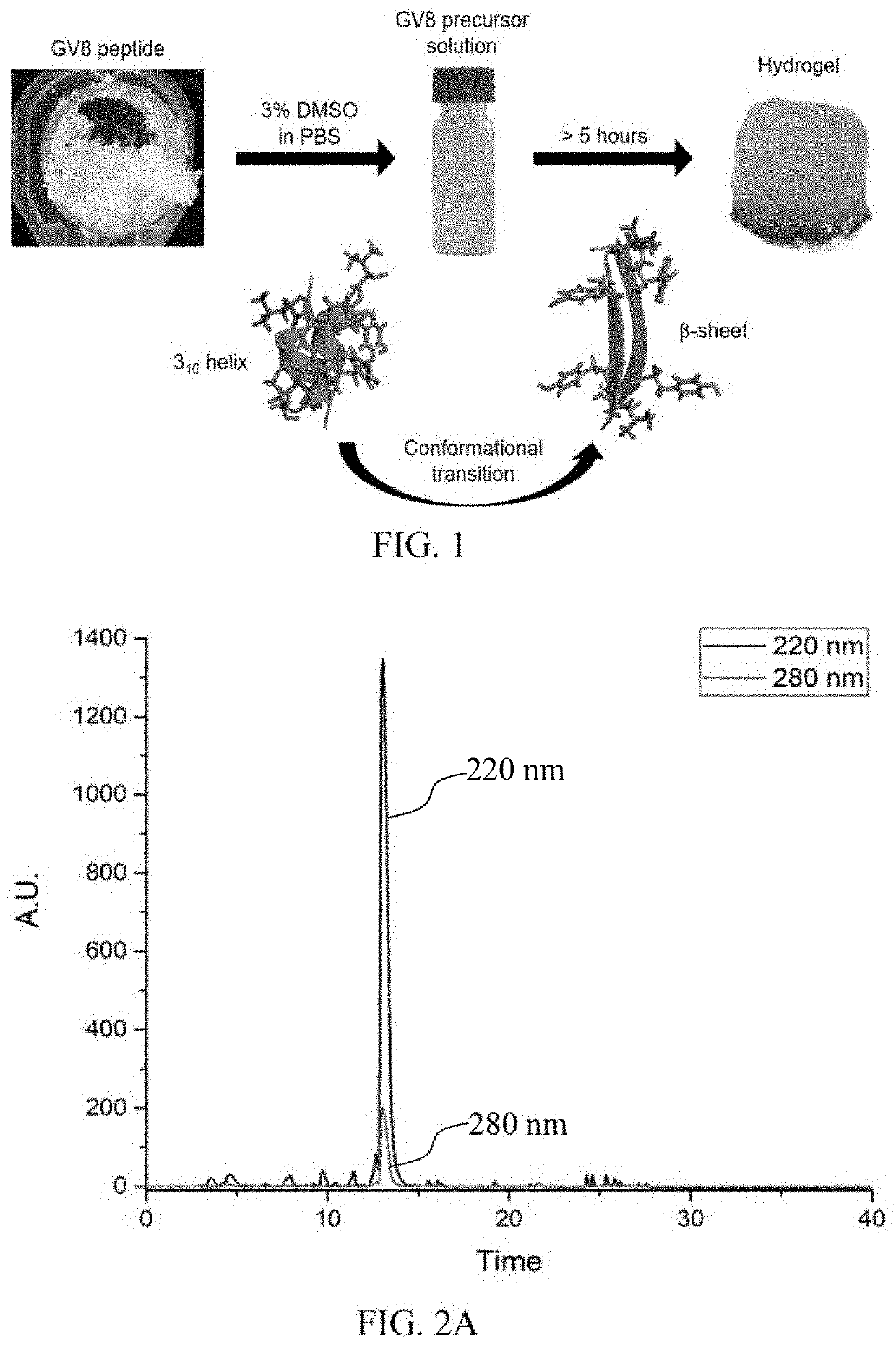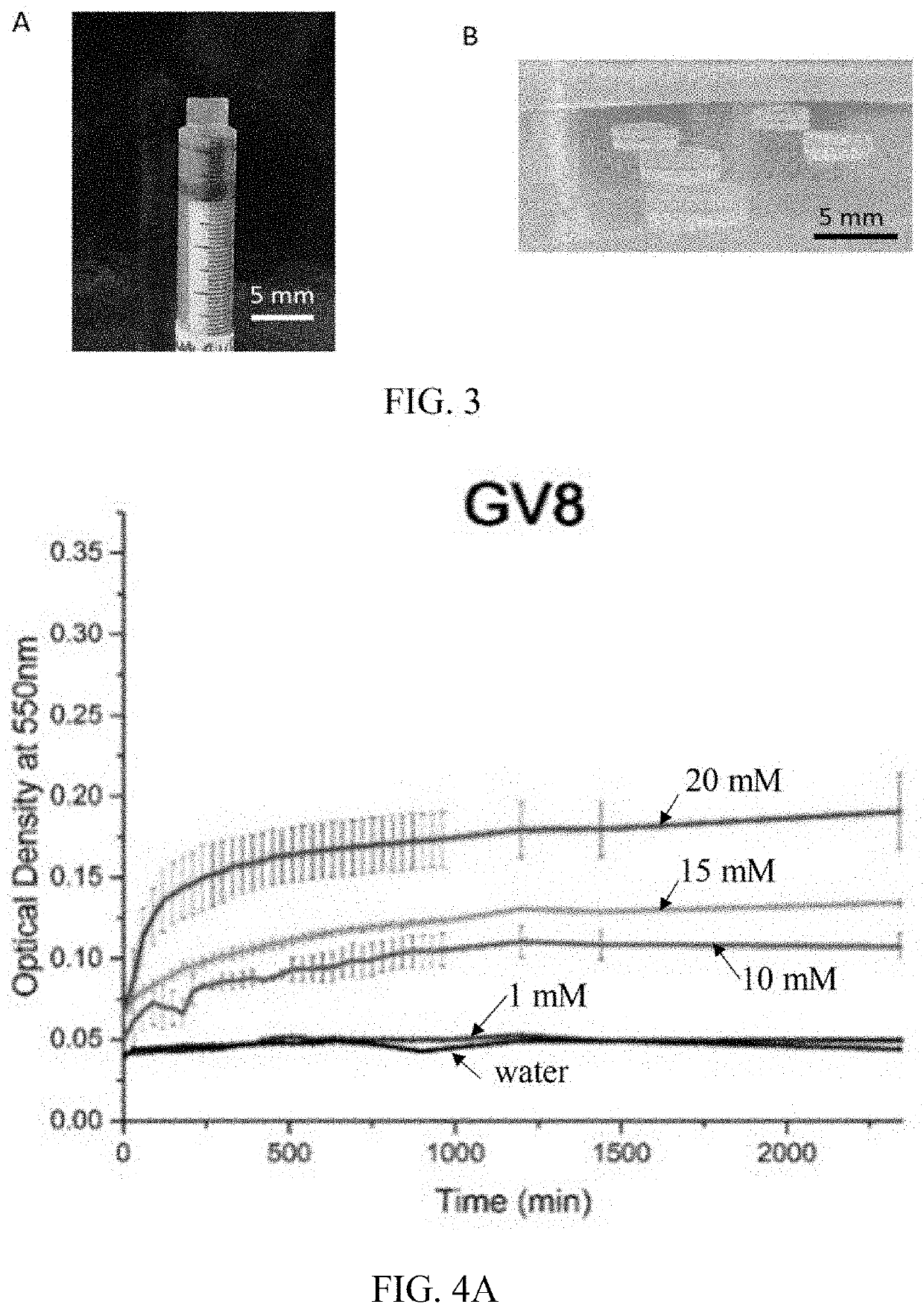Hydrogel-forming peptides, and methods of use thereof
a technology of hydrogels and peptides, which is applied in the direction of peptides, peptide/protein ingredients, prosthesis, etc., can solve the problems of limited approach, poor cell survivability in vivo, shortening the wound healing and recovery process, etc., and achieves excellent biocompatibility, enhanced structural integrity, and reduced degradation kinetics of hydrogels
- Summary
- Abstract
- Description
- Claims
- Application Information
AI Technical Summary
Benefits of technology
Problems solved by technology
Method used
Image
Examples
examples
Materials and Methods
[0133]Materials: Ac-GLYGGYGV-NH2 (SEQ ID NO: 7) (GV8) peptide, Ac-GLYGGYGI-NH2 (SEQ ID NO: 8) (GI8) peptide and Ac-GLYGGYGX-NH2 (SEQ ID NO: 11) peptides (where X=V, L, A, F, S, and K) were purchased from GL Biochem (Shanghai) Ltd. Peptides were checked to be >98% purity via trace HPLC and LC / MS prior to use. All of the peptides were acetylated at the N-terminal and amidated at the C-terminal to prevent end-to-end charge interactions. 13C-15N uniformly labeled GV8 crude peptide purchased from Cambridge Isotopes was purified to >95% purity via HPLC and checked with LC / MS prior to use.
[0134]In some embodiments, the Ac-GLYGGYGV-NH2 (SEQ ID NO: 7) (referred to as GV8 thereafter, i.e.) peptide was synthesized by solid phase peptide synthesis on rink amide solid support resins via Fmoc chemistry and cleaved in a 95% trifluoroacetic acid cocktail prior to precipitating in cold diethyl ether. The obtained peptide was purified to >98% purity with a C18 reversed phase prep...
example 2
2. Characterization of Secretome and VEGF Release by GV8+ Hydrogel
2.1 Rheology Characterization and Circular Dichroism
[0179]For the fabrication of secretome-loaded GV8+ hydrogel, secretome was loaded into the GV8 precursor prior to gelation. The resulting GV8+ hydrogels showed good structural integrity (FIGS. 3A and 3B), and had enhanced shear modulus (FIG. 19A), suggesting that the incorporation of secretome did not interfere with the overall gelation process, as shown in FIG. 20. The gelation kinetics observed from absorbance at 550 nm (FIG. 20A) indicates an increase in optical density during gelation before reaching a plateau, and the CD spectra obtained during the gelation process showed similar profiles (FIG. 20B) indicative of the 310 helix to β-sheet transition as reported above (FIG. 6E). Decreased ellipticity intensities of the CD spectra of GV8+ hydrogel with secretome (FIG. 20C) was anticipated and attributed to the increase in the amount of optically active amide bonds...
PUM
| Property | Measurement | Unit |
|---|---|---|
| temperature | aaaaa | aaaaa |
| temperature | aaaaa | aaaaa |
| time | aaaaa | aaaaa |
Abstract
Description
Claims
Application Information
 Login to View More
Login to View More - R&D
- Intellectual Property
- Life Sciences
- Materials
- Tech Scout
- Unparalleled Data Quality
- Higher Quality Content
- 60% Fewer Hallucinations
Browse by: Latest US Patents, China's latest patents, Technical Efficacy Thesaurus, Application Domain, Technology Topic, Popular Technical Reports.
© 2025 PatSnap. All rights reserved.Legal|Privacy policy|Modern Slavery Act Transparency Statement|Sitemap|About US| Contact US: help@patsnap.com



